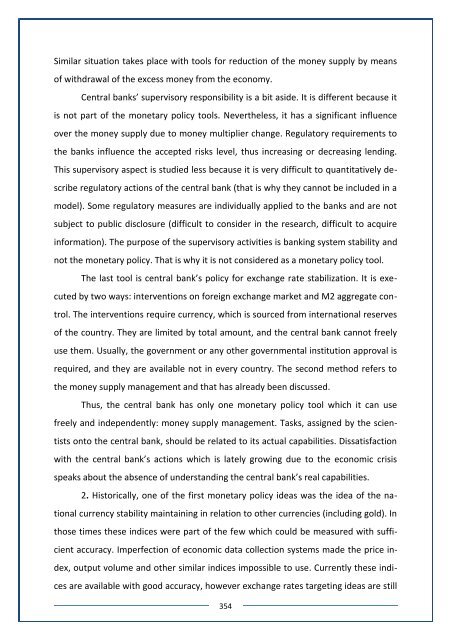ECONOMICS YEARLY REVIEW
Law_and_Economics_Yearly_Review_LEYR_Journal_vol_4_part_2_2015
Law_and_Economics_Yearly_Review_LEYR_Journal_vol_4_part_2_2015
You also want an ePaper? Increase the reach of your titles
YUMPU automatically turns print PDFs into web optimized ePapers that Google loves.
Similar situation takes place with tools for reduction of the money supply by means<br />
of withdrawal of the excess money from the economy.<br />
Central banks’ supervisory responsibility is a bit aside. It is different because it<br />
is not part of the monetary policy tools. Nevertheless, it has a significant influence<br />
over the money supply due to money multiplier change. Regulatory requirements to<br />
the banks influence the accepted risks level, thus increasing or decreasing lending.<br />
This supervisory aspect is studied less because it is very difficult to quantitatively describe<br />
regulatory actions of the central bank (that is why they cannot be included in a<br />
model). Some regulatory measures are individually applied to the banks and are not<br />
subject to public disclosure (difficult to consider in the research, difficult to acquire<br />
information). The purpose of the supervisory activities is banking system stability and<br />
not the monetary policy. That is why it is not considered as a monetary policy tool.<br />
The last tool is central bank’s policy for exchange rate stabilization. It is executed<br />
by two ways: interventions on foreign exchange market and M2 aggregate control.<br />
The interventions require currency, which is sourced from international reserves<br />
of the country. They are limited by total amount, and the central bank cannot freely<br />
use them. Usually, the government or any other governmental institution approval is<br />
required, and they are available not in every country. The second method refers to<br />
the money supply management and that has already been discussed.<br />
Thus, the central bank has only one monetary policy tool which it can use<br />
freely and independently: money supply management. Tasks, assigned by the scientists<br />
onto the central bank, should be related to its actual capabilities. Dissatisfaction<br />
with the central bank’s actions which is lately growing due to the economic crisis<br />
speaks about the absence of understanding the central bank’s real capabilities.<br />
2. Historically, one of the first monetary policy ideas was the idea of the national<br />
currency stability maintaining in relation to other currencies (including gold). In<br />
those times these indices were part of the few which could be measured with sufficient<br />
accuracy. Imperfection of economic data collection systems made the price index,<br />
output volume and other similar indices impossible to use. Currently these indices<br />
are available with good accuracy, however exchange rates targeting ideas are still<br />
354


